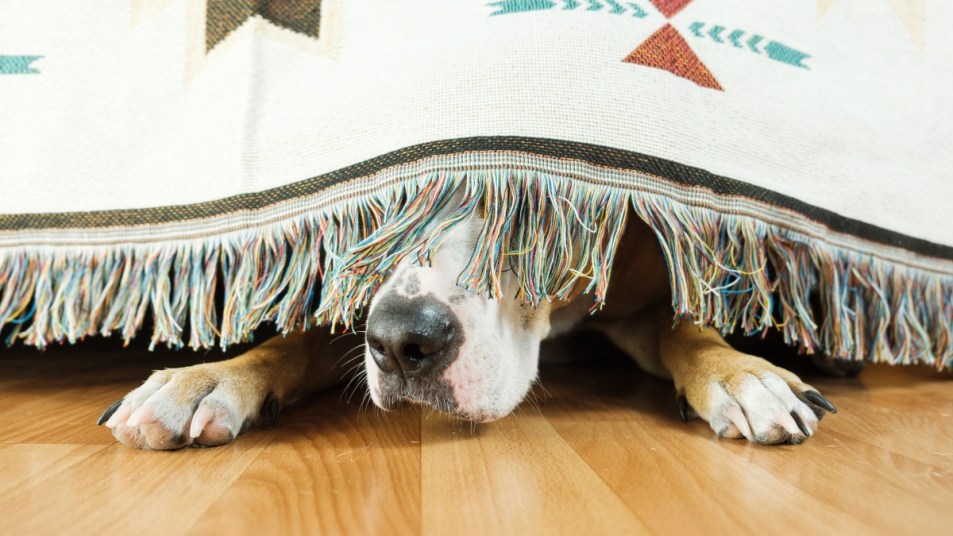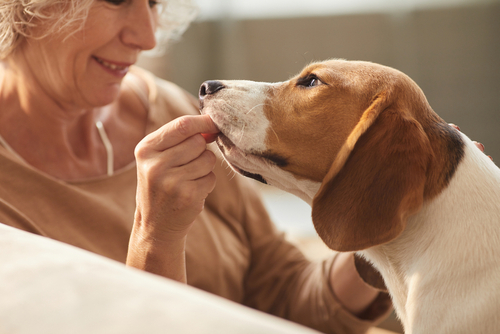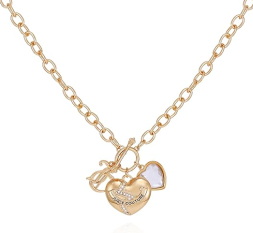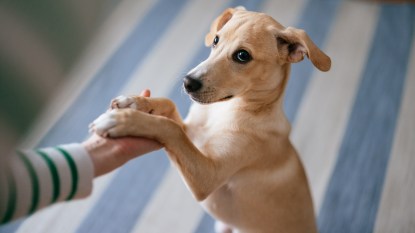Pro Trainers Reveal How to Increase Your Dog’s Confidence So You *Both* Are Happier
This simple "touch" trick can make all the difference for a timid pup!

There’s a reason people say dogs are man’s best friend. If you have a pooch, you know he can brighten your day with a simple wag of his tail. But even though he’s always happy to see you, he might not always happy, especially if he lacks confidence. Just like insecurities can make us feel worried and unsure, they’re also not good for your dog — physically and mentally. Low confidence can cause aggression and health problems, and if your dog has trust issues, that can cause the bond between you and your pup to break down. That’s why we asked the pet behavior experts for the telltale signs of a timid dog and how to increase your pup’s confidence.
What causes a dog to feel insecure?
Think about the times you were anxious or fearful. What made you feel that way? It could have been due to multiple factors, but often, we feel apprehensive when we don’t get the reassurance we need or we’re put into unfamiliar situations. As it turns out, dogs tend to lack confidence for similar reasons.
“There are three primary reasons a dog may have low confidence,” says Kait Hembree, VTS (Behavior), CVT, KPA CTP, head of training at GoodPup. Here, she outlines the top causes:
- Lack of socialization: A dog that wasn’t properly exposed to new experiences, people, places, sounds and more when they were young may continue to have trouble when faced with something out of the ordinary. The critical period? When they’re between 8 weeks to 14 weeks old.
- Lack of reinforcement: When a dog is not rewarded for desired behaviors, he may stop performing them.
- Punishment: Responding to a dog’s behavior with something negative or abrasive can decrease a dog’s confidence. He won’t want to try something if he didn’t have a good experience trying things in the past.
Nicole Ellis, a certified professional dog trainer and pet lifestyle expert with Rover, adds that some dogs might also simply be genetically predisposed to have less confidence than others.
Why low confidence is a concern
“A dog who is stressed or anxious may have more health issues, as stress is really hard on the body,” says Ellis. Hembree adds, “Over time, this stress can stack up, resulting in a dog expressing emotionally driven behaviors that are not ideal, like destruction, self harm or even aggression.” What’s more, those behaviors can negatively impact your bond with your dog. And it can also create dangerous situations around other people or animals.
How can you tell if your dog lacks confidence?
If you’re worried that your dog feels insecure, there are a few physical “tells” you can look for. “Dogs that lack confidence will exhibit body language suggesting they are uncomfortable with the situation,” notes Hembree. She says those signals include:
- Lowered or tucked tail
- Freezing in place
- Barking
- Growling
- Lunging
- Snapping
How to increase your dog’s confidence

Here, Hembree and Ellis share effective ways to build your dog’s confidence, so they feel happier and more secure. The common thread underlying each of these measures: positive reinforcement. Continuously rewarding your dog helps him build confidence. Punishing him for undesired behaviors only confuses him and build more anxiety. (Check out this story to learn more about why positive dog training works better than punishment.) Ready to help Fido feel more confidence? Try these three tactics:
1. Exposure to reduce your dog’s anxiety
“Slowly introducing your dog to things he’s nervous around and building up exposure with positive experiences and praise can lead to a more confident dog,” says Ellis. For example, if your dog gets nervous around strangers, take him on a walk in public. Keep him leashed, and give him a treat every time someone passes by. Don’t force him to engage, and stay calm if he starts to show fear. Make sure nobody approaches your dog without permission, and reward him for every positive interaction.
As time goes by, he will learn that people are good, and he doesn’t need to be anxious. “When dogs learn that making decisions and engaging with others earns them good things such as treats, pets and praise, then they will be eager to do more,” adds Hembree. “They learn that trying new things can be fun!”
2. Activities to boost your dog’s confidence
Keeping your dog busy with activities can help him feel more confident. Hembree recommends introducing enrichment toys like food puzzles. One option: A food puzzle toy (Buy from Amazon, $14.99) that encourages your dog to open boxes and move sliders to find bits of food. Toys like these engage your dog’s mind and force him to rely on his sense of smell while giving him an immediate reward for exploring. “Scent work teaches dogs to use their nose and search new environments when told and really can build up a dog’s confidence in the world,” says Ellis.
Agility courses also make your dog feel stronger and more self-assured. “ And you don’t have to find a fancy facility in order to teach your dog agility,” Hembree says. “There are tons of household items that can easily be used for putting together a small, informal agility course.” Check out some of these DIY dog agility courses that use things you already have around the house, like laundry baskets, chairs, and flower pots.
3. “Touch” training to make your dog’s feel safe
“We can also raise a dog’s confidence through training,” says Ellis. One behavior she recommends teaching your dog is “touch,” which directs your pup to touch his nose to your hand on cue. This behavior is helpful because it gives your dog a rewardable task to complete when he’s feeling nervous, and it gives people with whom he’s unfamiliar a “safe” way to interact with him. While a stranger petting his head might make him nervous, he knows what “touch” means, paving the way for a more positive interaction.
Follow these steps from Rover to teach your dog “touch”:
- Hold your outstretched palm a few inches from your dog’s snout. When he nudges it out of curiosity, reward him with a treat. Repeat this cycle 5 times.
- Start saying “touch” right before holding out your palm. Reward when your dog touches. Repeat another 5 times.
- Start moving your hand farther and farther away while practicing the cue, making your dog step toward you. Reward and repeat.
Because you love your dog, you want him to see the world as a good, safe place. Be patient with him as he learns, and don’t hesitate to ask for professional help.
Want to learn more about your dog’s behaviors? Check out these stories.
What Actually Prompts a Dog’s “Guilty” Look?
Dogs Like (and Understand) Baby-Talk — Here’s How What Scientists Call “Dognition” Works
When Dogs Cry — Here’s How To Tell if Your Pup Is Grieving, Plus Tips for Providing Comfort













